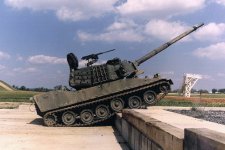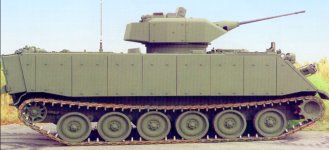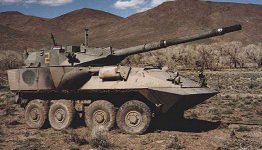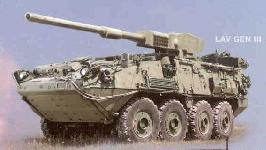






The Stryker Interim Armored Vehicle (IAV), so named because it is an interim system designed to bridge the gap between now and when the Army's future systems come online, provides the Army with a lighter and more mobile armored chasis to serve as the common baseline capability for a mounted Brigade Combat Team (BCT). The Army plans to equip its six Interim Brigade Combat Teams (ICBT) with variants based on the Stryker chasis. The Army will equip each ICBT with more that 300 IAVs, from a total production run of 2,131. The first Stryker vehicles were delivered to the 1st Brigade, 25th Infantry Division, in mid-2002, with the delivery of 280 expected by the end of the year. The Stryker IAVs will replace the LAV-IIIs, on loan from the Canadian government, with which the unit had been training (See Triggs 02).
The Army formally designated the IAV as the "Stryker" in Feb. 2002, honoring Medal of Honor winners Pfc. Stuart S. Stryker and Spc. Robert F. Stryker. Pfc. Stuart S. Stryker, 513th Parachute Infacntry, posthumously received the Medal of Honor leading an attack near Wesel, Germany that captured over 200 enemy troops and rescued three American pilots. Spc. Robert F. Stryker, 1st Infantry Division, posthumously received the Medal of Honor for saving the lives of his fellow soldiers near Loc Ninh, Vietnam.
The Army selected General Motors' General Dynamics Land Systems, the same company that produced the LAV for several other countries, to produce the IAV. In late 2000, the Army contracted with General Motors to produce 2,131 IAVs between 2001 and 2007 for approximately $4 billion. The primary variants GM will produce will be the Infantry Carrier Vehicle (ICV) and the Mobile Gun System, armed with the 105mm cannon tube that originally armed the M-1. GM will produce the ICV variant in multiple configurations including mortar carrier, anti-tank guided missile, reconnaissance, fire support, engineer support, medical evacuation, NBC reconnaissance and commander’s vehicle versions. Though not a tank replacement, the MGS variant will provided brigade with a direct-fire capabilitry to support infantry elements.
The IAV is transportable by C-130, C-5A, and C-17 aircraft. This mobility capability is critical to enable strategic maneuver of the IBCT through enabled operational and tactical intra-theater transport. The IAV will have a range of 330 miles cruising at 40 mph, capable of speeds up to 60 mph. The IAV features automatic fire suppression, a self-recovery winch, central tire inflation, and run-flat tires. Central Tire Inflation (CTI) provides the capability to vary tire pressures and vehicle mobility to match terrain, road, and weather conditions -- lower pressures for off road in soft soils, sand, mud and snow and higher pressures for use on-road where higher speeds are required.
In October 1999 the Army leadership announced a vision of the future. US forces must be lighter, more lethal and less dependent on logistic tails to rapidly deploy from multiple dispersed locations worldwide. Agile, highly capable forces that can react quickly to emerging crises may be able to prevent crises from escalating into war. US forces must be sufficiently versatile to sustain a high operating tempo and defeat an opponent with minimum losses. They must then quickly reposition, refocus, and execute subsequent missions against an adversary employing asymmetric means, including chemical/ biological warfare and information operations. An immediate upgrade of current forces is required in order to provide an interim capability to meet this requirement. To meet this interim requirement the Army provided funding in the FY01 budget to field an Medium/Interim Armored Vehicle as a common baseline capability for a mounted Brigade Combat Team (BCT) which will function as a full-spectrum combat force.
The Army Vision includes a Brigade structure and organization which is crucial to the Army’s strategic responsiveness goals of deploying, from the CONUS base to global theater of operation, one (1) Brigade within 96 hours, one (1) Division within 120 hours and five (5) Divisions within thirty (30) days. The air transportable Interim Brigade Combat Team (IBCT) is intended to be capable of deployment to anywhere on the globe in a combat ready configuration. The range of tasks to be accomplished by the IBCT requires a family of vehicles that are air transportable, capable of immediate employment upon arrival in the area of operations, and have the greatest degree of commonality possible. Force effectiveness is achieved by an organization built around mounted and dismounted infantry enabled by a family of internetted platforms and situational understanding.
The Medium Armored Vehicle (MAV) family of vehicles is centered on the Infantry Carrier Vehicle (ICV). The range of specific platform requirements will be met to the extent possible by applying Non Developmental Items (NDI) to the ICV. When specific platform requirements cannot be met to an acceptable level by applying NDI to the ICV, a variant may be used. Commonality with the ICV has priority over individual system performance. The two most likely platform variants are the Mobile Gun System (MGS) and the 155mm Self Propelled Howitzer.
- MAV Infantry Carrier Vehicle (ICV), when configured as an infantry carrier of Engineer Squad Vehicle, must carry an Infantry squad with individual equipment.
- The Mobile Gun System (MGS) must provide direct, supporting fires to assault infantry in order to destroy hardened enemy bunkers, machine gun, and sniper positions. To accomplish this the MGS primary armament must defeat a standard infantry bunker and create an opening in a double reinforced concrete wall, through which infantry can pass. The main armament system capable of providing a firing rate of 7-12 rounds per minute for at least 2 minutes. It will possess a shoot-on-the move capability, with laser rangefinder, to defeat MBTs (up to T-72M) out to 2000M (Threshold), 4000M (Objective).
- The SP Howitzer will integrate athe Light Weight 155mm (M777)cannon system with capabilities equal to or greater than the Lightweight 155 (M777) on a common chassis within the IBCT and be capable of firing all currently fielded and developmental US and North Atlantic Treaty Organization (NATO) Standard 155mm munitions and propellants. In addition the system must be able to achieve a range of 30 kilometers (assisted) and be able toachieve a maximum rate of fire of not fewer than five rounds per minute for three minutes in low angle (less than 800 mils elevation) indirect fire.
The MAV equipped force is composed of mission specific variants/configurations (V/C), each of which provide the vehicle operator/crewman with a series of functional capabilities, some of which have previously not been available. To maximize commonality, the number of configurations will be minimized, and the various functions to be performed will be tailored to that small number of configurations.
VARIANTS SYSTEMS PER VARIANT Self-Propelled Howitzer 15-21 Mobile Gun System (MGS) 30-42 Infantry/General Purpose Carrier (ICV) 130-180 Reconnaissance Vehicle 54-73 Antitank Guided Missile Vehicle (ATGM) 10-14 Command and Control/TOC Vehicle 40-56 Mortar Carrier 30-42 Engineer Vehicle (EV) 17-23 Striker/Fire Support Team Vehicle 11-15 NBC Reconnaissance Vehicle 3-5 Medical Evacuation/ Medical Treatment Vehicle 35-48 Recovery Vehicle 5-8 TOTAL SYSTEMS PER BRIGADE 380-527
Specifications
Stryker ICV Stryker MGS Manufacturer General Dynamics (Land Systems Division) Crew 11: Driver, Vehicle Commander, 9 Troops 3: Driver, Vehicle Commander, Gunner Weight 19 Tons 20.69 Tons Length 275 inches Width 107 inches Height 104 inches 106 inches Gap 78 inches Vertical Climb 23 inches Power Rating 350 HP Speed - Maximum 60 mph Cruising Range 330 Miles Main Armament
- Mk 19 Grendade Launcher
- Mk 2 .50 cal machine gun
- Mk 240 7.62mm machine gun
M68A1E4 105mm cannon Commander's Weapon .50 Cal M2 Machinegun Coaxial Weapon 7.62 M240 Machinegun



